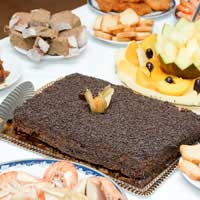Designing Your Menu For Your Cookery Group

Running a cookery group is about discovering new ways to eat your favourite foods – and new ways to eat your most hated foods! The perfect menu gives everyone the opportunity to try something new or unusual. It’s also important to make it nutritionally balanced with options for people who choose low fat or vegetarian diets. Here’s information about the essential food groups and how to relate this to the needs of your own cookery group.
The Food Groups
At your first Cookery Group meeting, it can be useful to discuss members’ dietary needs and preferences. It’s also a good idea to refresh your nutritional understanding. Despite the latest trend towards low-carb diets, national guidelines still tell us that we should be eating foods from the five basic groups every day.- Fruit and Vegetables: By now everyone knows that we should incorporate 5 a day into our diet. Choosing fruit and vegetables of different colours is a good way to try and include a variety of vitamin types – for instance, green veg are rich in iron and calcium; berries, peppers and carrots provide essential vitamins A and C.
- Starchy Food: This group covers bread, potatoes, rice, pasta and cereal. It should represent a third of your daily intake. Choosing wholegrain options means that the energy is released more slowly through your day, and these options will also contain more fibre – making digestion easier.
- Milk and Dairy: This group shouldn’t be cut out of your diet, even if you’re trying to lose weight. It always has a place in a healthy meal – and these days you can choose strong cheese, so you need to use less, or skimmed milk, which contains the same amount of calcium and vitamins as full-fat milk. Dairy products are particularly important for children and teenagers, pregnant women, and those with osteoporosis.
- Proteins: This group covers fish, meat, eggs and pulses. Your protein serving should represent about 12-15% of your plate, less than half of the amount of starch. Vary your selection to include white and oily fish, pulses, red meat and poultry. Vegetarians get their protein from pulses or lentils, some of which actually provide more protein per gram than meat alternatives.
- Fats and Sugars: Only about 6% of your daily intake should be fat or sugar. Don’t forget that these can be present in other foods on your plate. But we do need some fat – and there’s a difference between good and bad fats. Olive oil, fish, nuts, and avocados are all high in the good, unsaturated fats, which provide essential fatty acids.
Discovering Low Fat Options
One week, give your Cookery Group a theme of ‘Low Fat Options’. This can be more fun than it sounds! Give your members a challenge of producing meals with less than 3% fat – and see if you find a new favourite. You could experiment with fat-free French bread, vegetable or lentil soup flavoured with spices and tomato, root vegetable stews, spicy chillis or curries using lean cuts of meat and low-fat yoghurt dips, fajitas with stir-fried chicken, fruity jellies and meringue pavlova. Doesn’t sound so bad, does it?A Balanced Menu
Now that you have discussed the food groups, you’re in a good position to select your menu. Don’t forget to include a meat or fish and vegetarian protein, a starchy accompaniment such as mashed potato or pasta salad, and a vegetable side dish containing a bright mixture of colours (or two dishes with different veg). You can also work out how much you will need to feed the group, using the food plate:- Meat, Fish or Pulses (15%) = 150g per person
- Potatoes, Rice, or Bread (30%) = 300g per person
- Vegetable Side Dishes (30%) = 300g per person
Related Articles in the 'Cookery Masterclass' Category...
- Making Pavlova and Roulade
- How to Make a Great Cheesecake
- Cooking With Lentils
- Cooking Your Own Smoked Food
- Italian Classics to Cook at Your Group
- Making your Own Ice Cream
- Cooking Pies and Pastry
- Holding a Cookery Group Masterclass
- French Classics to Cook at Your Group
- A Guide to Cake Decorating
- Masterclass: The Art of Presentation
- Cooking on a Budget in Your Cookery Group
- English Classics to Cook With Your Group
- A Masterclass in Indian Classics


Re: Cooking and Freezing in Bulk
Many thanks for your response, that is extremely helpful even if a little complicated. I have printed this article and will pass…
Re: Cooking and Freezing in Bulk
@ Iain beg McAndrew - I think Delia refers to a 'buttery kedgeree' which isn't suitable for freezing because it is too oily. I…
Re: Cooking and Freezing in Bulk
You say that kedgeree is suitable for freezing, Delia says that it is not. As I am preparing a buffet for some 20 and wish to…
Re: Cookery Group Topics to Cover & Consider
Those are all great activities, but you can also offer to provide dishes for other groups, say for a bake…
Re: Meals for Five Pounds or Less
Cool, but, I'm looking for snacks, not meals, that you don't use an oven for (ours is broken). (but Microwaves are fine)